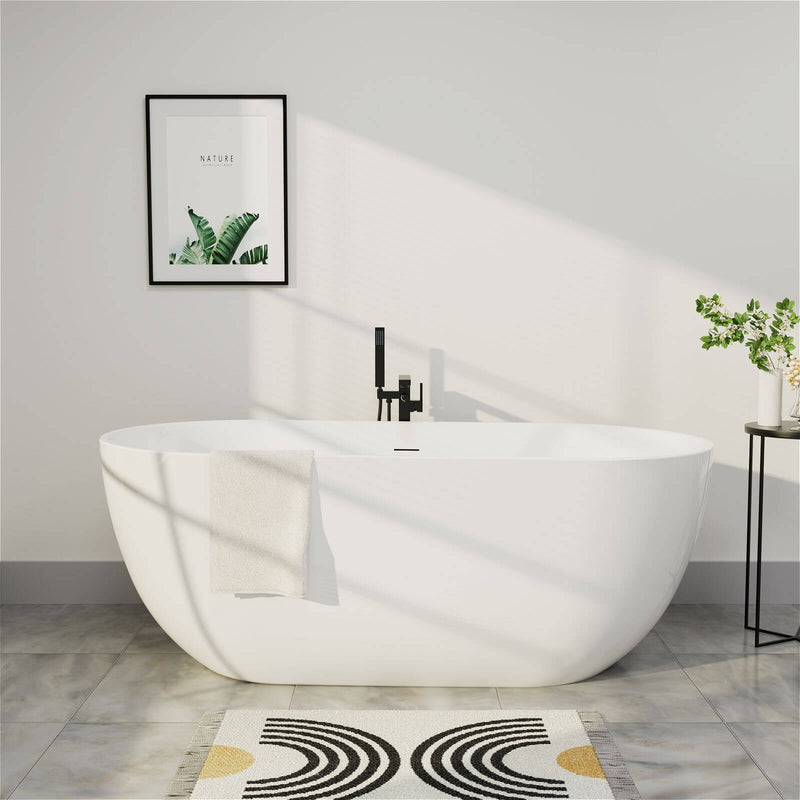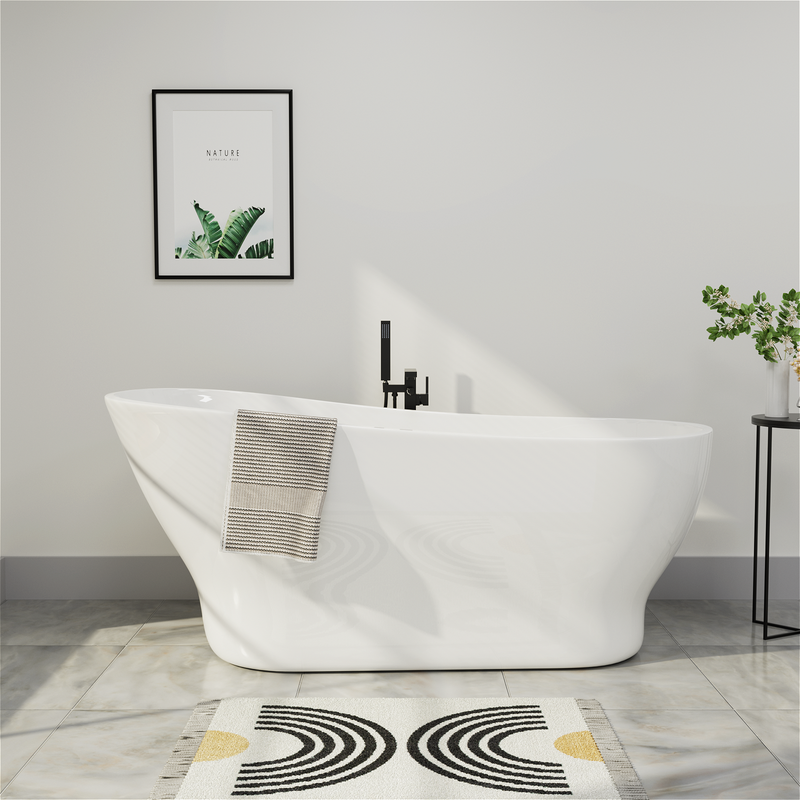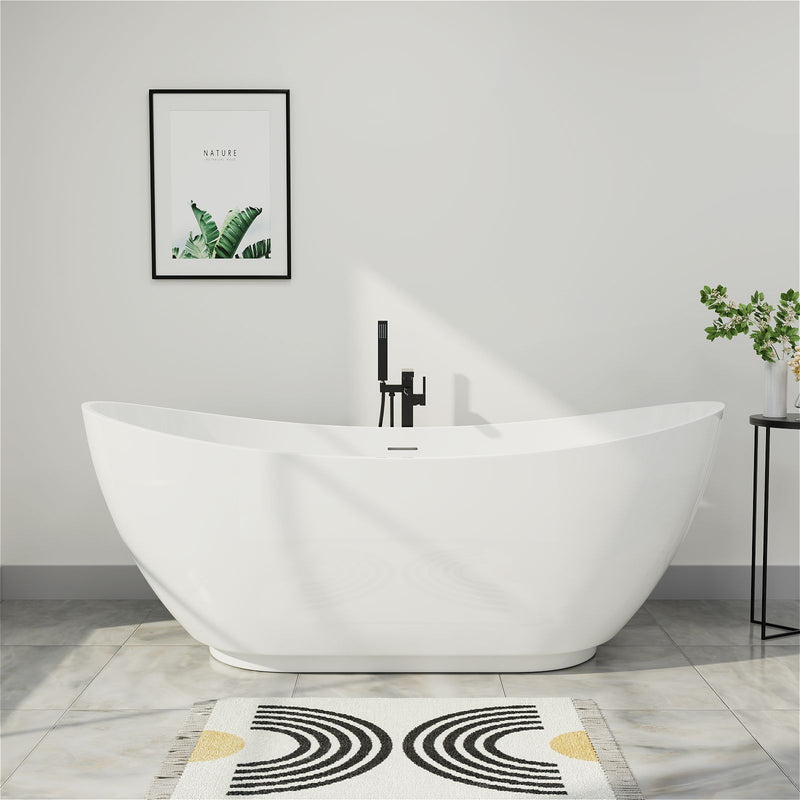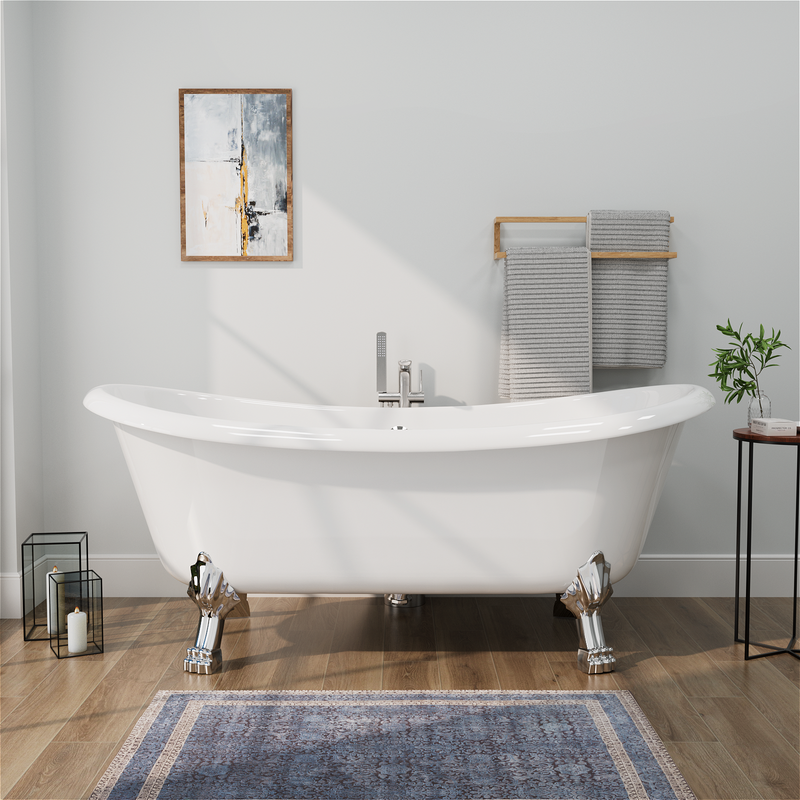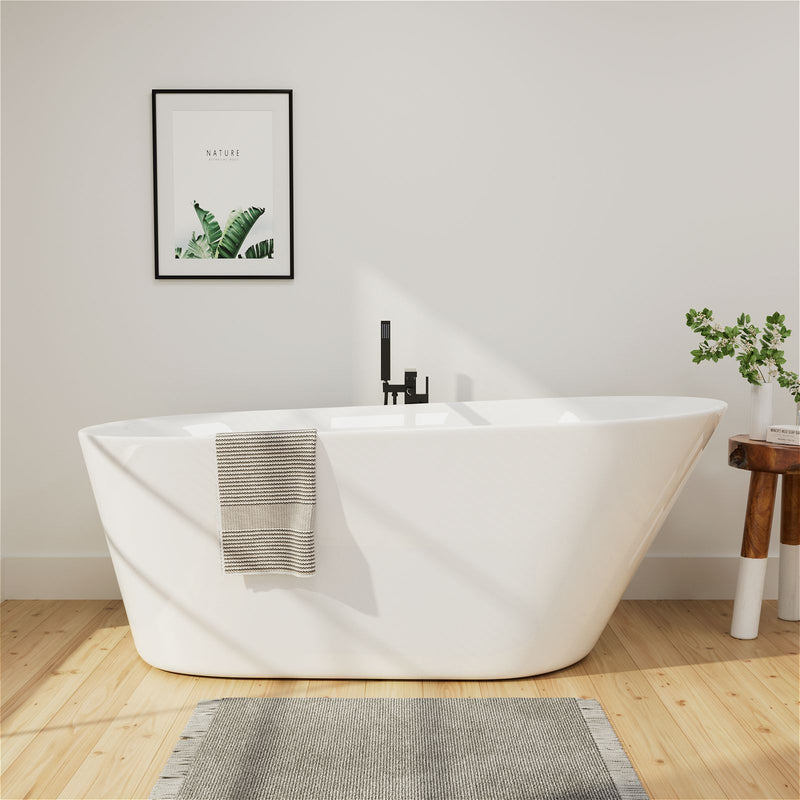When choosing a bathtub for your home, many people default to the familiar Western-style tub. But in recent years, Japanese soaking tubs—deep, upright, compact tubs modeled on the traditional ofuro—have gained popularity among homeowners and design enthusiasts, especially in the wellness and spa communities. A Japanese soaking tub offers a different bathing experience, one rooted in ritual and deep immersion, while the Western tub remains popular for its lying-down comfort and versatility.
If you're considering adding a new tub (or replacing an old one), understanding the real differences between Japanese soaking tubs and Western tubs can help you choose what fits your lifestyle, bathroom layout, and personal preferences. In this article, we'll compare them in detail across design, comfort, health and wellness benefits, installation and maintenance, use cases, and potential drawbacks.
Japanese Soaking Tub vs Western Tub: What's the Difference?
Before diving into comparisons, let's clarify definitions.
- Japanese soaking tub — Often called ofuro, these tubs are deep, relatively short in length, and designed for upright or semi-upright soaking rather than lying flat.
- Western tub — The more familiar form in U.S. homes: longer and shallower, designed for the bather to recline or stretch out partially in a horizontal position.
In Japan, ofuro baths are traditionally for soaking and relaxation, not cleaning. Bathers first wash themselves outside the tub, then enter the water for the soak. Western tubs, in contrast, typically serve both washing (soap, shampoo) and soaking in one unit.
The key design contrast is vertical vs horizontal orientation: Japanese tubs emphasize depth (vertical immersion) over length, while Western tubs emphasize horizontal length for a reclining posture. That difference influences nearly every aspect of user experience, installation, and performance.
Design, Space, and Materials
Depth, Footprint, and Shape
One of the most conspicuous differences is depth. Japanese soaking tubs are significantly deeper—commonly 15–25 inches (38–63 cm) or more—so the bather can immerse up to the shoulders or neck while sitting upright. In contrast, many Western tubs have depths in the 12–18 inch range, making full-body immersion harder without stretching or partial submersion.
Because Japanese tubs are deep, they often have a smaller footprint in terms of length and width. They may be more compact in floor space (e.g. narrower or shorter) while still offering full immersion. This can be a major advantage in smaller bathrooms. In contrast, Western tubs tend to be longer to allow reclining posture, so they require more floor length.
Shape also differs: Japanese tubs often tend toward square or more vertical-walled designs, with steep walls rather than sloped backs. Some even incorporate built-in bench seats for comfort. Western tubs often use sloped backs and ergonomic contours to allow more comfortable reclining positions.
Materials & Heat Retention
Materials for both tub styles vary, but the choice has more effect in deep tubs because water volume and heat loss are more critical.
Common materials include:
- Wood (cedar, hinoki, teak, etc.) — Traditional in Japanese tubs. Wood offers natural beauty, pleasant aroma, and good insulation if properly maintained. But wood requires maintenance (sealing, preventing warping or mold) and may have limitations if you use soap or bath salts.
- Acrylic / Fiberglass — Lightweight, easier to shape, lower cost, and lower maintenance. These are common in both Japanese-style tubs and Western tubs in modern installations.
- Stone / composite / solid surface — Premium option. Offers durability, stylish aesthetics, and good heat retention. But heavier and more costly.
- Metal / Stainless Steel / Copper — Less common but used in some specialty or contemporary designs.
Because Japanese tubs are deep, heat retention is important. A deeper tub often has less surface area relative to volume (especially if not excessively wide), which can help slow heat loss. But good insulation, lids, or covers are often used to reduce heat loss further.
Drainage, Overflow, and Plumbing Considerations
Traditional Japanese furo often do not have overflow drains; they may be designed to be filled to brim and then drained manually when done. Some modern units include overflow features or recirculation (oidaki) systems to maintain water temperature.
Western tubs generally include built-in overflow and standardized drainage plumbing, which simplifies installation in many U.S. homes.
Because of depth and water volume, plumbing for Japanese tubs may require careful attention to water supply (hot water heater capacity, flow rate) and drainage capacity (to allow quick fill and empty). Some users report that Japanese soaked tubs take a long time to fill and consume much of the available hot water if not planned properly.
If you plan to retrofit a Japanese-style soaking tub into an existing bathroom, you may need to adjust piping, ensure the floor can bear extra weight, and consider ventilation (especially with deeper hot water use).
Bathing Experience & Comfort
How You Sit / Soak
In a Japanese soaking tub, you sit upright or semi-erect, often against a vertical wall or slight backrest, letting hot water envelop your torso and limbs. The posture is deliberate, almost meditative. Because the tub is deeper, your waterline typically rises to your chest or above, depending on water level and your height.
In a Western tub, you recline, lean back, or partially stretch your legs; water covers only portions of your body depending on depth and fill level. The sensation is more horizontal, with your back partially supported.
Which one feels more comfortable often depends on your height, preference for lying down vs sitting, and bathroom layout.
Immersion & Heat Efficiency
Because Japanese tubs focus on deeper immersion in a compact footprint, they allow your body to be more fully submerged in hot water. That can mean a more enveloping, heat-rich experience without having to fill a huge tub horizontally.
Also, as noted earlier, deeper tubs can benefit from lower surface-to-volume ratios (less exposed surface area) and thus reduce heat loss, helping your bath stay warmer longer. You can often use a lid or cover to reduce evaporation and preserve warmth further.
A Western tub filled to higher levels may lose heat faster because more surface area is exposed (wider span). This often necessitates higher water volumes or reheating systems to maintain comfort.
Water Use & Efficiency
A common claim is that Japanese soaking tubs can be more water-efficient, because though they are deep, they are narrower or more compact in area, so their total volume (when filled to soak level) may be less or comparable to filling a Western tub for partial soaking.
Some sources suggest that Japanese tubs require less water for full immersion, which is beneficial for water and energy conservation.
However, these benefits depend heavily on the specific tub dimensions. A very deep and wide Japanese tub may consume more water than a shallow Western tub, so careful planning is required.
Health, Wellness & Safety Benefits
Circulation, Stress Relief & Muscle Relaxation
Immersion in warm water has been shown in various studies and wellness literature to aid in blood circulation, help relax muscles, relieve tension, and reduce stress.
Because Japanese soaking tubs promote full-body immersion, those benefits may be more completely experienced than in partial submersion.
Additionally, many advocates of soaking claim improved skin health (opening pores, cleansing) and better sleep or mental relaxation. A scientific review of Japanese-style bathing (JSB) noted benefits such as warming the body, recovery from fatigue, refreshed feelings, and enhanced sleep.
Potential Risks & Safety (Especially for Elderly Users)
While many benefits are real, there are some known risks, especially for older adults or people with health vulnerabilities. The same JSB review mentioned a concerning statistic: many accidental deaths in Japan occur in bathtubs during winter among the elderly. Sudden changes in body temperature or cardiovascular stress may play a role.
To mitigate risk:
- Don't let water get too hot (control temperature).
- Avoid sudden standing or exiting from deep, hot water.
- Ensure the bathroom surface is non-slip, and consider grab bars or seating assistance.
- For older adults or those with cardiac conditions, consult a physician before use.
Mindfulness & Ritual
One non-quantitative but meaningful difference is the ritualistic, serene nature of Japanese soaking. The design encourages quiet, mindful immersion, a pause from screens and stimuli. This quality appeals to wellness-centered homeowners.
While a Western tub can also be relaxing, it is often more utilitarian (washing + bathing) rather than dedicated to pause. In Japan, it's common to wash first, then enter the tub clean, turning the soak into a deliberate relaxation period.
Use Cases & Suitability in U.S. Homes
Which Home / Bathroom Layout Fits What?
Small bathrooms / tight layouts: Japanese soaking tubs often win because of their compact footprint. You can get full immersion without needing a long tub zone.
Larger bathrooms or master bathrooms: A Western tub may offer more lounging and a broader aesthetic canvas, plus options for dual-person soaking.
Homes prioritizing wellness / spa feel: A Japanese soaking tub can become a showpiece, specialized for the soaking ritual.
Families or multi-user households: Western tubs may better accommodate children or shared use (lying down, more flexible space).
Retrofitting existing plumbing: Western tub style may often align better with standard U.S. plumbing and drain setups, reducing remodel complexity.
Behavior & Cleaning Considerations
If you adopt a Japanese-style soak routine, the practice typically goes: wash and rinse thoroughly before entering the soaking tub, so that soap and dirt don't contaminate the soaking water. In many Japanese homes, multiple people share the same water sequentially. Soap residue, hair, or debris is removed after the session, and the water is drained or covered.
Caution: Wooden soaking tubs may be incompatible with heavy use of soap or harsh cleaning chemicals, unless properly sealed and maintained. Acrylic, stone, or composite tubs may tolerate cleaning more readily.
Challenges & Potential Drawbacks
Height / comfort for tall users: Some tall users may find their knees or head constraint restrictive in a short, deep tub.
Water heating & hot water capacity: Deep immersion requires significant hot water. If your water heater or plumbing can't deliver, you may need upgrades.
Drainage speed: When a tub is very deep, draining quickly may require larger drain capacity to avoid long wait times.
Maintenance and upkeep (especially wood): Wood requires sealing, protective care, humidity control, and occasional repair.
Cost: Materials like stone or premium wood, or custom deep tubs, can be expensive — especially with structural floor loading, plumbing modifications, or professional installation.
Safety considerations: As discussed, deeper hot water immersion may raise risk for vulnerable individuals if precautions aren't taken.
How to Choose / Design Well (with Mokleba in Mind)
If you are considering installing or buying a Japanese soaking tub (for example via Mokleba's offerings) in a U.S. home, here are key criteria and design tips:
Measure carefully
- Ensure floor footprint fits.
- Account for vertical depth and ceiling clearance (especially with walls of fixed height).
- Check structural support—deep tubs can weigh a lot when full.
Water system compatibility
- Check whether your water heater can deliver volume and temperature.
- Assess plumbing and drainage capacity (pipe sizes, venting, slope).
- Consider whether a recirculation/heater system (oidaki) is included or needed.
Insulation & covers
- Use a lid or cover to reduce heat loss and evaporation.
- Choose materials (wood, acrylic, stone) that work with insulation and climate.
- Good sealing or liners help longevity.
Material selection vs maintenance
- If you prefer low maintenance, acrylic or composite may be safer than wood.
- If you want traditional aesthetics, wood can enhance the visual and sensory experience—but plan for upkeep.
Ease of access & safety
- Plan for safe ingress/egress (steps, handrails).
- Consider non-slip surfaces.
- Ensure temperature controls are accessible and safe.
User comfort testing
- If possible, test sit-down experience (legroom, headroom) before purchase or installation.
- Consider how different family members (tall vs short) will feel in the tub.
Balance between ritual and utility
- Decide whether the tub is primarily for soaking/relaxation (as a spa-like feature), or also for functional bathing.
- If you plan to use it for showers or soap use, ensure material choices resist wear or chemical damage.
With these considerations, Mokleba's design and manufacturing quality can be leveraged to produce high-performance, durable, and enjoyable soaking experiences.
FAQs
Q1: Will a Japanese soaking tub use more hot water than a Western tub?
It depends on design. Because Japanese tubs are deeper, they require more vertical fill, but their narrower footprint may offset some volume. If you choose a very wide deep tub, it may use more hot water than a modest Western tub. Always compare actual volume specifications. Also, good insulation and covers help reduce waste.
Q2: Can I retrofit a Japanese soaking tub into a standard American bathroom?
Yes, often—but with caveats. You'll need to check plumbing (water heater capacity, pipe sizing), drainage, structural floor support, clearance, and ventilation. Some layout changes or upgrades may be necessary. Custom or modular deep tubs help with retrofit flexibility.
Q3: Are Japanese tubs comfortable for tall people?
They can be—but it depends on dimensions. Because they emphasize depth not length, very tall users may feel constrained in legroom or headspace. Choosing models with extra internal length or optimal internal shaping helps mitigate this.
Q4: Do Japanese soaking tubs keep water warmer longer?
Often yes. Their deeper design reduces surface area exposure relative to volume, which means less heat loss per unit of water. Using lids or covers further helps maintain temperature.
Q5: What cleaning routine is needed, especially for wooden tubs?
- After each soak, rinse the tub with mild, non-abrasive cleaner and soft cloth.
- Remove any debris or hair before the next use.
- For wood tubs, reseal or re-oil periodically to protect against moisture damage or cracking.
- Avoid harsh chemical cleaners or strong soaps that degrade wood or finish.
- Ensure proper ventilation to prevent mold and mildew.
Q6: Is it safe for older adults or people with health issues?
Caution is advised. Deep, hot water immersion can stress the cardiovascular system or raise risk of slipping or sudden temperature change. Moderation of temperature, gradual entry/exit, non-slip surfaces, and possibly medical consultation are prudent.
Q7: Why choose Mokleba over generic brands?
When selecting a brand (like Mokleba), ensure they design for deep soaking, deliver quality materials and insulation, support U.S. plumbing standards, provide warranty and customer support, and optimize for durability (especially for deep tubs). A dedicated soaking tub brand will often manage the engineering challenges (heat retention, drainage, structure) better than a general bathtub brand retrofitting a deep tub.
Conclusion
Choosing between a Japanese soaking tub and a Western-style bathtub isn't just about appearance—it's about how you want to bathe, your bathroom constraints, and the experience you seek.
If your goal is a deep, meditative soak, compact space efficiency, and a wellness-focused ritual, a Japanese soaking tub can deliver a unique, enveloping experience. On the other hand, if your priorities are lounging horizontally, simpler retrofitting to standard U.S. plumbing, or shared bath usage, a Western tub might make more sense.

